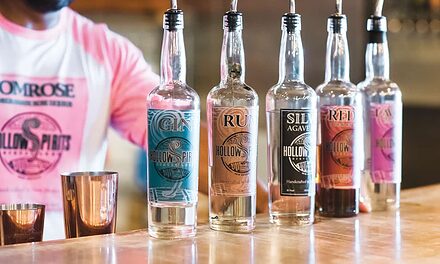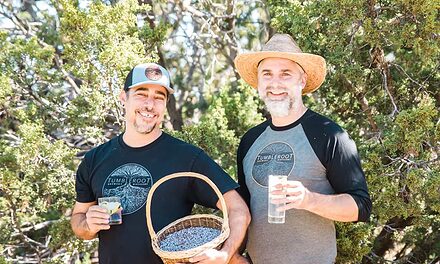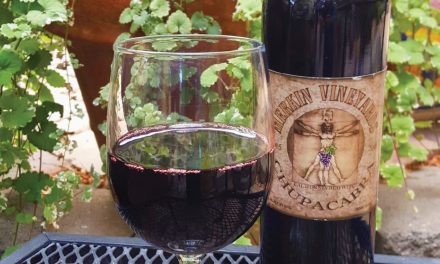

When Laurent Gruet describes the process of making sparkling wine, it sounds less like a set of instructions and more like a favorite song. In quick cadence and a thick French accent, he guides you through the essential steps: midsummer harvest, pressing the grapes, bottling the wine, aging the wine, adding the yeast, triage, dosage, and voilà.
It is difficult for Laurent to pinpoint the moment he internalized how to make sparkling wine, as it came to him as more of a birthright than a chosen craft. “When you are from Champagne, it’s everywhere, it’s part of life,” he says. Laurent says he was probably five years old when he had his first taste of his family’s vintage, “and the next year, a little bit more.” Laurent grew up around the winery and the winery grew up around him. In 1952, Gilbert Gruet, Laurent’s father, first began experimenting with champagne. He dreamed of producing on a large scale. This ambition led to the formation of the UVCB, a co-op in his village, Bethon. Gilbert mentored his son from a young age, and Laurent started formally working for the family at age sixteen. He can recall early memories of his father explaining the way yeast multiplies, transforming still wine into the sparkling beverage of his heritage. In 1984, Gilbert moved his family to New Mexico in search of vineyard land abroad. The family toured Texas and California before settling in New Mexico, which was considerably more affordable. With seed grapes from California, processing equipment from France, and Chihuahuan desert soil, the Gruet family began producing near Truth or Consequences. In 1987, Gruet produced two thousand cases. Since that time, the family has expanded its production with two additional vineyards: Luna Rossa, also in southern New Mexico, and another on the Santa Ana Pueblo. Last year, Gruet produced roughly 2.4 million bottles.
When most out-of-staters think of New Mexico, they imagine a dry, hot, unforgiving place, a land where vegetation is prickly or non-existent. When the Gruet family came to New Mexico, however, they saw a unique opportunity in the arid heat. “It was perfect,” Laurent recalls, because “less moisture meant less rot.” The Gruet family would not have to contend with the complications of humidity and could therefore count on a more consistent harvest. The cool desert nights were also beneficial; the drop in temperature slows the maturation of the grape, controlling acidity.
Laurent’s intimacy with the family vineyard is distinctive to Gruet. “True champagne is raised by hand,” Laurent tells me. He notes the importance of grape variety (Gruet grows chardonnay and pinot noir exclusively) and full cluster pressing. “It’s done very gently,” he says. “It makes a huge difference.”
For Laurent, the ultimate way to enjoy a glass of champagne is by itself, “as an apéritif, when your palate is clear.” If taken alongside food, Laurent prefers seafood, particularly oysters. “For my birthday, always,” he says. When asked how the culture of drinking sparkling wine has changed throughout Gruet’s history, Laurent notes its growing popularity as an everyday drink, no longer reserved only for Christmas, New Year’s Eve, and birthdays. Now, we are just as likely to order a glass of sparkling as a glass of red when out to casual dinner on a weeknight. Despite its diffusion into mainstream food and drink culture, champagne will forever symbolize celebration. A glass can turn an ordinary ritual—weekend breakfast, for example—into something special.
A bracing, pre-noon bubbly (with or without orange juice) is the ideal contrast to buttery French toast, salty bacon, and sugary pastries. Champagne is probably best loved at breakfast in the form of a mimosa. The origins of the mimosa stretch back to the 1920’s in Britain, where a bartender at London’s Buck’s Club served the Buck’s Fizz. The simple drink was made of two parts champagne and one part orange juice. It was a simple excuse to encourage drinking early in the day. In 1925, the Hôtel Ritz in Paris officially created the mimosa, made with equal parts champagne and citrus juice. The name likely came from the Acacia dealbata (mimosa) flower, whose delicate cascade of pale yellow blooms resemble the effervescent trails in a glass of champagne. Gruet honors the tradition—and current popularity—of mimosas with occasional mimosa bar events held at one of their tasting rooms in Albuquerque or Santa Fe. Here, you can sample various fresh juices and syrups mixed with Gruet’s sparkling varieties. It is a good way to learn whether you’re more of a Buck’s traditionalist (more champagne) or a Ritz purist (sweeter).
In addition to his passion for sparkling wine, Laurent has a great love for still wine. He is most excited about producing a still rosé for Gruet: “Like what we drink on warm summer evenings in France,” he says. Gruet’s Brut Rosé is wildly popular; no doubt a still equivalent would be equally successful. Laurent is proud of the vineyard, history, and business he and his family have cultivated in the Southwest. He hopes Gruet can serve as an example of the potential for growth, of all kinds, in New Mexico. We can all toast to that.
8400 Pan American NE, Albuquerque, 505-821-0055
www.gruetwinery.com
Edible celebrates New Mexico's food culture, season by season. We believe that knowing where our food comes from is a powerful thing. With our high-quality, aesthetically pleasing and informative publication, we inspire readers to support and celebrate the growers, producers, chefs, beverage and food artisans, and other food professionals in our community.












